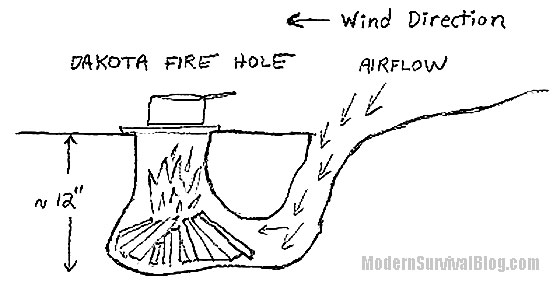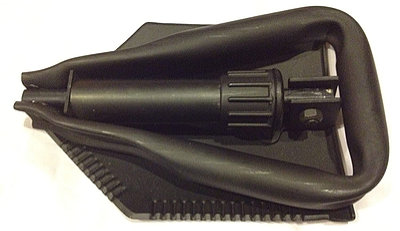Advantages of the Dakota Fire Pit – Smokeless & Hot

A Dakota Fire Pit is simply a method of building a fire that utilizes a number of advantages over other types of fires.
It will burn hot, it will use little wood, and will release very little smoke.
Some call it a smokeless fire pit.
First though, here is how to build a Dakota Fire Pit…
How to dig a Dakota Fire Pit
Dig The Pit
Dig a hole about a foot (or less) in diameter and about a foot deep.
It’s helpful to enlarge the bottom of the pit by several inches to accommodate longer pieces of firewood than the surface hole diameter. This will be the chamber of the fire pit.
It’s always nice to have a camp shovel!
US GI Military Original Issue E-Tool Entrenching Shovel
(view on amzn)

Airflow Tunnel
Next, dig the airflow tunnel. Dig the airway tunnel beginning about one foot away from the fire chamber hole.
The diameter of the airflow hole should be about six inches and will angle down towards and into the bottom of the main fire chamber.
Ideally this airflow hole should be upwind from the main fire hole.
Kindling / Twigs / Sticks
Fill the fire pit partway with kindling and light the fire. Gradually add sticks to build a stronger fire.
The fire creates a suction which is drawn into the airflow tunnel, resulting in a much hotter and efficient burning fire.
[ Read: Tinder For Building A Fire ]
[ Read: A Fire Starter Kit (List) ]
Advantages of the Dakota Fire Pit
– The fire burns very hot.
– Less firewood is needed than conventional fire methods.
– Food or water will cook / boil faster.
– The efficiency of the burn creates less smoke, which means less visibility.
– This method is particularly useful and manageable if it is very windy compared to other methods.
– The fire burns below the surface of the ground which shields the flame from being seen, especially at night.
Since the fire is below the surface, green sticks across the top of the hole, or other methods can be used to easily support cookware.
When finished, the evidence of a fire is easily removed when you fill the holes with dirt and cover the surface with natural surrounding material.
Tips
– To further diffuse any potential smoke (if that’s a concern), build the Dakota fire pit near the canopy of a tree to help avoid detection.
– Choose an area with favorable soil. Avoid rocky or rooted areas.
– Be wary of soil which may ooze with moisture or fill with water.
– Be sure the fire is out when you’re done! Be cautious that the fire is not smoldering roots (or peat) beneath the surface – which could potentially ignite afterwards.
[ Read: Best Knife For Batoning Wood (Recommendation by Dave Canterbury) ]

